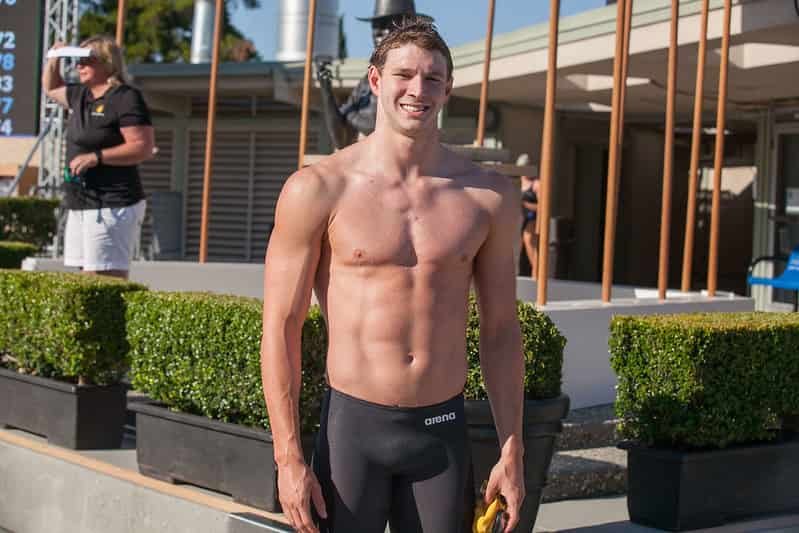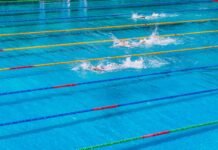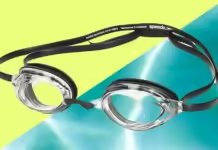Get Stronger and Faster in the Pool: The Best Strength Training Exercises for Swimmers
Looking to boost your power and speed in the water? Strength training is key to improving your swimming performance. But there are many myths and misconceptions in our sport about weightlifting and its role in swimming.
Some common myths include:
- “Weightlifting causes injuries.”
- “Strength training needs to exactly mimic swimming movements.”
- “Lifting weights will make me too bulky for swimming.”
In reality, when done correctly, strength training helps swimmers reduce injury risk, fix muscle imbalances, and provide a performance boost through post-activation potentiation. Plus, it helps you swim faster.
One of the biggest benefits of weightlifting isn’t just how you look in the mirror—it’s the ability to strengthen muscles that are often overworked. Think of all the repetitive overhead and front-body movements involved in swimming. This can lead to rounded shoulders, tight hips, and sore knees.
But you’re here for the best strength exercises to improve your swimming, right?
When it comes to strength training for swimmers, there are plenty of factors to consider:
- Selecting exercises that target your swimming goals
- Your age and experience level
- How often you lift and the volume of your training
- Properly timing your strength workouts to peak during the season
Based on over 30 years of experience in the sport, research, and advice from Olympic swimmers and physiotherapists, I’ve compiled a list of my top strength training exercises for swimmers. This list will help you build strength, reduce injury risk, and become a faster swimmer.
Let’s dive in!
1. Pull-ups
Pull-ups are a simple and highly effective exercise that targets a lot of the same muscles that you use to haul yourself through the water, making it an essential part of your dryland workouts. Pull-ups most noticeably hit your lats, helping you develop that overhead-and-pulling-down power that gets you through the water.
But there’s more: pull-ups also target your t-spine, forearms (helpful in strengthening your early vertical forearm), traps, arms, and shoulders. Not bad for an exercise that doesn’t require any equipment outside of a sturdy weight-bearing pull-up bar.
According to his 2009 autobiography, No Limits, the GOAT, Michael Phelps, could do up to 34 pull-ups in a row. Olympic 100-meter freestyle champion Nathan Adrian can do them with up to an additional 130 pounds dangling off his waist.
“This exercise helps increase my strength-to-weight ratio in a movement that directly translates to the pool,” Adrian says.
Although banging out a metric ton of reps might boost self-confidence, the priority is doing pull-ups properly and with correct technique (just like anything else in the gym or in the pool, for that matter).
According to a study published in the Journal of Strength Conditioning Research, titled “Relationship Between Dryland Strength and Swimming Performance: Pull-Up Mechanics as a Predictor of Swimming Speed,” researchers evaluated and tested a group of competitive swimmers to see if pull-up strength correlated with swimming speed.
Sure enough, the group of twelve male swimmers, with an average age of 19 years, who swam fastest had the best mechanics on the bar. It wasn’t who did the most repetitions, but the swimmers who did pull-ups with the best mechanicsthat swam fastest.
As in the pool, technique is king when it comes to strength training for swimmers.
The progressions and variations with pull-ups are almost endless. For beginners, start with simple hangs and inverted body rows before progressing to assisted and negative pull-ups.
“I love pull-ups,” says Ryan Murphy, Olympic and NCAA champion backstroker. “You can do so many different variations of overhand and just really isolate the lats. You can do underhand and get a little bit of biceps in there. You can go wide grip and get a little bit of chest so there’s just so many different kinds of variations of pull-ups.”

2. Dumbbell Bench Press
The barbell bench press is a strength training O.G. And it’s undoubtedly one of the best ways to develop muscle and power in your upper body.
But for swimmers, who require a high degree of scapular stability, and who aren’t exclusively focused on building muscle mass, the barbell bench press comes with some limitations.
With the upper back pinned to the bench, the shoulder blades are immobilized. The dumbbell variation of the bench press allows the shoulders to move in a more natural pattern, with a greater range of motion.
There are a few other reasons I prefer the dumbbell bench press over the traditional barbell:
- First, you can target each arm individually, helping to address muscle imbalances (fun fact: muscle imbalances are one of the leading causes of swimmer’s shoulder).
- Second, you use a more natural grip with dumbbells that reduces strain on the wrists, elbows and shoulders. Again, protecting the shoulders.
- Third, the single and alternating versions of the dumbbell bench absolutely hammers your core. The anti-rotation component is awesome for swimmers as it mimics the demands we face in the water.
- And fourth, dumbbells are far more practical in terms of learning the movement, gym space (there are only so many bench press benches), and loading (dumbbells require less spotting as you can drop them to the side if too heavy).
3. Squats
Fast swimmers have strong legs and a fast kick.
Training the kind of kick that helps you close your swim races is built in the pool, doing lots of kick and focusing on improving technique, but power and strength come from the gym.
Squats have practical implications in two obvious areas:
- Generating power and explosiveness off of the start. Getting off the blocks, both in terms of distance and speed, requires strong legs and hips.
- Maximizing speed and power off of the turns. Whether you are doing a flip turn or a two-handed touch into the wall, when you complete rotating/turning, your feet are planted on the bulkhead or wall and you push off from a squat position.
These are the two sections of the races where swimmers are moving at peak speed.
Every meter between the start and turns is spent just trying to hold onto the speed that you start with.

So yeah, squatting is important. And research has shown repeatedly (Science! More science!) that squatting can significantly increase jumping ability and explosiveness.
When it comes to the best squat, that is a whole other debate. I love using jump squats because they require no equipment (perfect for those home-based workouts) and explosive movements are simply fun.
Balancing the plyometric nature of squat jumps with weights is a proven way to develop strength and speed.
When it comes to heavy squats, Olympic backstroke champion Ryan Murphy prefers front squats versus back squats as they force the lifter to really brace their core.
“I’m not a huge fan of back squats,” he says. “It’s easy to hurt the back and I’m much more of a proponent of front squats. You really have to brace the abs and hold your body upright. You can’t do as much weight, but it’s really a whole-body exercise.”
4. Glute Bridges
Swimming is an anterior-dominant activity. This means that the front of the body is the driver of action most of the time, which means that your posterior (glutes, hamstrings, calves, lower back) are under-developed from thousands of reps of anterior-dominant movements.
One of my favorite exercises of all time for swimmers is the glute bridge.
You lay on your back, and raise your pelvis off the floor, driving your heels into the ground, firing muscles up and down the posterior chain from your lower back to your calves.
There are three ways you can use glute bridges in your strength training programming:
- As an activation exercise before you get in the water. Put a resistance band around your knees and do 3×15 slow and controlled reps to engage those muscles that are run dormant from sitting all day.
- As a strength-building exercise. The barbell hip thruster is the weighted version of the glute bridge, typically performed with your shoulders on a bench and with a barbell across the front of your hips. As someone who has had knee problems on and off over the years, this exercise is a pain-free way to generate a ton of activation on my backside and get stronger. As you progress with this exercise, use a hip thruster pad to protect the hips and pelvis while lifting. It will keep the bar stable and prevent the barbell from digging and bruising into the hips as you push more and more weight.

- As a core and stability exercise. Swimming fast requires exceptional body control and stability in the water. One of my favorite variations of the glute bridge raising my butt off the floor, and then lifting and straightening one leg and doing small and controlled flutter kicks. (You can draw “O’s” with your toes for an additional challenge.) The hip and core stability from this exercise carries directly into your ability to maintain a stiff and strong body position in the water.
5. Broad Jumps
Swimming is a unique sport for a lot of reasons. The weightlessness, the relentless focus on improving efficiency, the battle against the density of the water.
On top of that, we have a key part of our race that cannot be trained in the water: the start.
The start has always been important, but swimmers like Flo Manaudou, Brad Tandy, Bill Pilczuk (here’s a quick history lesson on Bill and how his devotion to a fast start upset the best sprinter in history), and most recently, Caeleb Dressel and his world-beating start have shown how game-changing an explosive start can be.
The technique of the swim start is something you should be working at while you are at the pool. Having a clean entry, not having your hips sink too deep, and using your arms to pull you forward and propel you through the air.
But getting more distance off the blocks and more velocity starts in the gym, and one proven exercise for accomplishing both of these goals is the broad jump, a plyometric exercise that both beginners and Olympic-level swimmers can do.

According to a paper titled “Plyometric Long Jump Training With Progressive Loading Improves Kinetic and Kinematic Swimming Start Parameters” published in the Journal of Strength Conditioning Research, found that a plyometric program focused on broad jumps increased horizontal velocity and distance off the start.
The intervention was a 9-week dryland program that prioritized broad jumps. For the first two weeks, the swimmers did 8×2 broad jumps twice a week. For the following seven weeks, 15×2 reps. The jumps were performed off a small platform that was angled the same as a regular starting block.
At the end of the seven weeks, the swimmers generated 7% more horizontal force (getting further off the block) and picked up a 16% increase in horizontal velocity (getting faster off the block).
With broad jumps, the key is explosive power, so take generous amounts of rest between sets (the study cited above had the swimmers resting for two minutes between sets).
Stick the landing with “soft” feet. And make sure that you are measuring the distance to keep yourself focused and accountable to good form and maximum effort.
Getting Started with Strength Training for Swimmers
And now for your regularly scheduled disclaimer. Weight training is a tool to help your performance in the water. Use it to complement your training. (And as always–check with your doctor and coach before undertaking any type of physical training program.)
With that out of the way, here are some tips for making strength training a durable fixture of your training program:
Swim-specific or Nah?
Often, swimmers and coaches will go a little overboard with sport-specificity when it comes to dryland and lifting weights. They will only replicate swimming movements on the pool deck and add load.
And the idea makes sense: train the movements on dryland that you want to perform in the water.
But strength training isn’t just about training yourself to perform on race day, it’s to help strengthen you to withstand long bouts of training, injury-proof your water-training, and address imbalances and strength deficiencies.
Strength training for swimmers should focus on developing a stronger athlete. Faster swimming will happen naturally as a result.
Progress intelligently.
A curious thing I see with swimmers who are very proficient in the water is that they think this automagically translates to the gym. Done improperly, weight-lifting is a quick and easy way to injure yourself.
One paper followed an NCAA Division I swim team for four years and half of the training injuries the swimmers incurred happened outside of the water.
Have a plan that progresses, allows for sufficient recovery, and doesn’t leave you crippled with DOMS after the first session.
Form first. Always.
Look, I get the temptation to walk into the weight room for the first time and load up the bar and hammer time on the reps.
But if you haven’t lifted before, or haven’t lifted in a long while, stick to technique and bodyweight work to get started.
Even if that means starting with lifting with “just” your bodyweight.
“Focus on mastering proper movement mechanics with your own body weight,” says Jason Dierking, the strength and conditioning coach for the University of Louisville’s swim team. “Having the ability to squat, hip hinge, and perform a perfect chest-to-floor push-up will put you ahead.”
If you aren’t able to lift with proper form and function not only are boosting the likelihood of hurting yourself, you also aren’t getting the proper benefit and improvement from the exercise. Total double fail.
Total weight might be good for the ego, but total form is what will help you swim fast, get properly strong, and reduce injury.


















